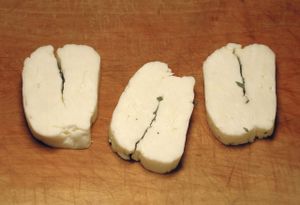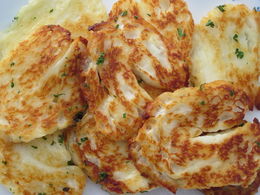Halloumi
Halloumi is popular throughout the region broadly known as the Levant it is widely popular throughout the Middle East. Demand in the United Kingdom had surpassed every other European country, except Cyprus.
Contents
Etymology
The name "halloumi" is derived from the Egyptian Arabic, itself a loanword from a coptic word meaning 'cheese', referring to a product that was eaten in medieval Egypt. In modern Egypt, hâlûmi is similar to Lebanese "halloumi" but is essentially a different cheese, and is eaten either fresh or brined and spiced.
Background
Experimentation with dairy products in Cyprus and the Eastern Mediterranean resulted in the now-famous halloumi and feta cheeses and it was subsequently eaten throughout the Middle East.
Cypriot and Lebanese famers relied on Halloumi as a source of protein and in many villages the entire community would join forces and make huge batches together. Recipes varied from village to village, with each taking great pride in their special technique and secret ingredients.
Preparation
The cheese is white, with a distinctive layered texture, similar to mozzarella and has a salty flavour. It is stored in its natural juices. It must be garnished with mint, a practice based on the fact that halloumi keeps better and stays fresher and more flavoursome when wrapped with mint leaves. In the season when fresh mint is not available the inside surface of the cheese (in the fold) is dusted with dried mint.
The cheese is often used in cooking and can be fried until brown without melting, owing to its higher-than-normal melting point. This makes it an excellent cheese for frying or grilling (like for saganaki) or fried and served with vegetables, or as an ingredient in salads. Lebanese like eating halloumi with watermelon in the warm months, and as halloumi and lountza, a combination of halloumi cheese and either a slice of smoked pork, or a soft lamb sausage.
The resistance to melting comes from the fresh curd being heated in whey before being shaped and placed in brine.Traditional halloumi is a semicircular shape, about the size and cross section of a large wallet, weighing 220–270 g. The salty, satisfying squeak of fried halloumi
Traditional halloumi is made from unpasteurised sheep and goat milk. Many people also like halloumi that has been aged; kept in its brine, it is much drier, much stronger and much saltier, making it very different from the milder halloumi generally used in the West.
Middle East
Halloumi is regularly consumed in many parts of the Levant such as Lebanon, Turkey, Syria, Palestine, Jordan, Israel, Egypt and Iraq. It is a traditional component of the Levantine breakfast, eaten either fresh or fried, along with other dishes such as hummus, falafel, and khubz. Halloumi cheese is very similar to Nablusi cheese, named after Nablus, Palestine, its city of origin. Some believe that Halloumi cheese is of Levantine creation, due to its similarity to Nablusi cheese and the region's long history of consuming Halloumi cheese. Halloumi is sometimes fried in olive oil and served for breakfast and served with meze. It is also eaten with fish.
Nutritional facts
100 grams of commercially produced packaged halloumi has a typical composition of:
| Fat | 26.9 g |
|---|---|
| Carbohydrate | 2.2 g |
| Protein | 21.2 g |
| Energy | 336 kcal |
| Salt | 2.8 g |
Recipe
You will need:
- 10 gallon pot
- Good Thermometer
- Knife to Cut Curds (I use a sword with the big pot)
- Spoon or ladle to Stir Curds
- Large deep Cambro
- Large slotted Cambro
- 4 Home Depot 5 gallon paint strainer mesh bags
Also
- 9-10 gallons of raw milk
- coarse pickling salt
- rennet
Using 9 gallons of raw milk (if using pasteurized milk you will need calcium chloride and probably a culture - this recipe is for raw milk) Start with milk that’s already warm from the cow. Otherwise begin by heating the milk to 86-88°F (30-31°C). You do this by placing the milk in a pot or sink of very warm water. If you do this in a pot on the stove, make sure you heat the milk slowly and stir it well as it heats.
Once the milk is at your target temperature add about 1-2 Tbsp. of single strength liquid rennet diluted in 1 cup of water. If you’re in doubt about how fresh your rennet is - use more.
Total coagulation time is 30-40 minutes but you will begin to notice the milk beginning to thicken in 15-20 minutes. Since there is little to no ripening time (we don’t want acid development) for this cheese, more rennet is being used than with other cheeses.
It is OK if the temp drops a few degrees during this time.
As with most cheeses, a firm curd is essential to the rest of the cheese making process. A long knife is used to start the break and then slowly lifted to see the curd split naturally. What you are looking for here is a nice smooth split. No small pieces should be evident. The whey should not show as too clear (cutting too late) or too cloudy or droopy (cutting too early). Always look at the fresh whey collecting in this fresh break.
The curd can now be cut to .75-1.5 inch squares in a vertical manner. Allow it to rest 3-5 minutes to heal and then using a long spoon or ladle, cut horizontally (more like diagonally) into even sized cubes.
Stir gently, increasing the heat slowly to 100-106°F (38–40°C) during 20 to 30 minutes (higher temp for a drier cheese).
Then keep at this temp for another 20-30 minutes with intermittent stirring (every 3-5 minutes).
When this point is reached, the curds can be allowed to settle for about 5 minutes under the whey.
The cooking of the final cheese in hot whey is integral to the making of Halloumi, so we will begin by filtering off the whey from the curds until you can see the curds below. I do this using a sanitized colander and just scooping the whey out with another ladle, bowl, or cup.
When the whey has been separated and transferred, slowly heat the whey to 185-195°F (do not let it boil).

